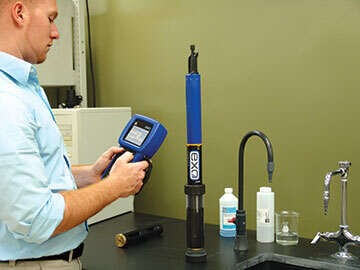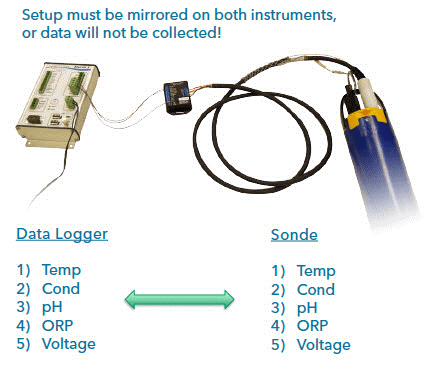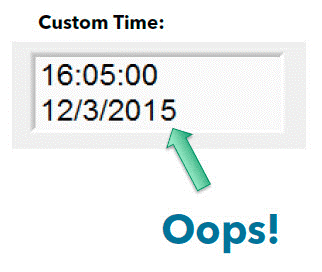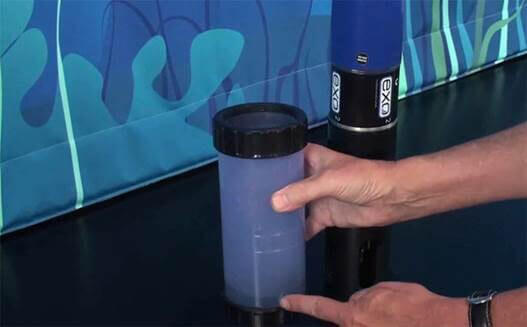5 Tips to Prevent Costly Mistakes with Your Water Quality Sonde
Do you have an issue with your water quality sonde?
So, you phone your manufacturer and begin troubleshooting your problems with them, hoping that the two of you can solve the problem fast and efficiently. But what about alternative possibilities? Do they exist? Yes, you are welcome to read this blog article written by our specialists! We collaborated with our product managers, sales team, and technical support professionals to discover the top five most expensive water quality sonde faults.
Mistake #1 - Calibration Issues
For most people, calibration is the most difficult aspect of utilizing sondes, yet it's also the most important for gathering high-quality data.

There are several nuances to each phase of a calibration that a beginner user may ignore, not to mention the fact that certain sensors require you to produce your own calibration standards, which can lead to a slew of other complications.
So, let's limit our talk to some of the most common errors we encounter.
a) Using Expired Standards - calibration standards have an expiration date, and each bottle of standard is labelled with this information.
A standard's lifespan begins the moment it is made; for pH standards, this is normally two years, but it varies from standard to standard due to chemical composition differences.
However, once the package is opened, the shelf life is dramatically reduced.
So, in the case of the pH, once opened, it will last about 6 months. To put this in practical terms – expired standards are kind of like expired milk. Yes, you can definitely drink some that is a few days old, but should you take the risk? You're introducing a layer of uncertainty to the accuracy of your data once the expiration date has passed In a multi-point calibration, even using one expired standard can affect the calibration, since calibration points often build off one another behind the scenes.
If you use sondes occasionally throughout the year, it's a good idea to write the open date on the bottle so you know when it'll expire and avoid any confusion.
b) Unclean Equipment
So, while we're on the subject of contamination, another consideration is the cleanliness of the equipment we're calibrating.
It's one of the most common calibration problems we notice, especially with turbidity probes. This probe is reading negative values, therefore there must be something wrong with it. In most situations, this is due to a lack of calibration.
Zero-point calibrations for optical sensors, but turbidity, are susceptible to contamination during calibration. If there’s any residual dust, grime, biofouling left on the probes, sonde bulkhead, or sensor guard (Basically anything that will be in contact with the standard), then essentially, we’re calibrating our 0 NTU cal point using a 1 or 2 NTU standard. In some cases, this difference may be so small that it will not matter. In environments like drinking water reservoirs, where there are very low turbidity levels – improper cleaning will manifest itself in the field when you see something like a -1 to -3 NTU turbidity reading.
So what’s the lesson here?
Before you calibrate, thoroughly clean all your equipment, and when you think you've done so, clean it again.
If you're working in low-turbidity situations, it's also a good idea to have a second sensor guard on hand that you only use for calibrations. This eliminates one potential source of contamination. The essential point is that even something as basic as cleaning should not have an influence on the integrity of your data.
c) Taking Shortcuts
The simple truth is that just about everyone reading this has a to-do list a mile long. It’s the new standard these days. It's no wonder, therefore, that we're all seeking for ways to save time in almost every aspect of our lives. Cutting corners during calibration, on the other hand, is not a good idea..

In a standard calibration process, our equipment manuals always recommend rinsing the calibration cup, sensor guard, and probes with your next standard at least twice prior to performing a calibration. Some groups’ standard operating procedures (SOP) may even be more thorough, so be sure to follow your own organization’s rinsing policy. Before going on to the next point in a multi-point calibration or the next sensor that needs calibration, the washing procedure guarantees that no traces of prior standards are left on the equipment.
To give a practical example here: Let’s say you need to calibrate a Turbidity probe and a pH probe for a day of sampling. After you’ve successfully calibrated the Turbidity probe with NTU standards, it’s important to rinse the calibration cup with your first pH buffer at least twice before proceeding with a pH calibration. This ensures that none of that Turbidity standard is left to contaminate your next cal.
d) Calibration Points and Standards to Use-another area where users may have difficulty
With conductivity probes for example – If you’re monitoring in freshwater you want to use a 1000 micro-siemen standard, in brackish water a 10000 micro-siemen standard, and in seawater a 50000 micro-siemen standard. When calibrated with the appropriate standard, the probe becomes more accurate in certain ranges. Also, one quick note on conductivity standards – even if your monitoring site runs far lower than 1000 micro-siemens, always calibrate with a 1000 standard. Anything else is susceptible to contamination.
But what about when you’re starting to monitor a new field site? Sure, it’s easy to decide whether I’m monitoring fresh water, salt water or somewhere in between and decide on a conductivity standard, but what something less obvious like pH or turbidity?
Our advice, if you’re unsure about the environment you’re going to be measuring, always calibrate to the full range of the probe. If we’re talking about pH – perform a 3-point calibration at pH 7, 10, and 4. If we’re talking about turbidity – perform a 3-point calibration at 0, 124, and 1010 FNU. This way the probe is ready to provide the highest quality data for whatever happens in the field.
Let's review what you've just read about water quality sonde faults:
- Don’t use expired standards
- Read the standards labels carefully
- Make sure to clean your equipment thoroughly before calibrating
- Avoid taking shortcuts in calibration like skimping on rinsing
And if you’re not sure which standards and calibration points to use, try to get a better read on your monitoring location – if all else fails, calibrate over the full range of the sensor
Mistake #2 - Incorrect Setup (Continuous Monitoring)
a) Data loss was one of the greatest challenge last year for monitoring organization
A few check boxes can really make a big difference. Setting up a sonde incorrectly can lead to a host of problems, including lost data or incomplete data records. This is a monitoring organization’s worst enemy because there’s no way to rewind time to know what happened at your site.
With new technology like EXO, we’ve streamlined the number of settings required to get your equipment up and running. Eliminating potential for errors during instrument setup was a key point of emphasis for us. With other sondes however, there are numerous options and menus for determining how an instrument collects data in the field. Setup is often complicated and navigating your way through the software can be tricky. Let’s go through a few hurdles in the setup process to help you avoid problems with your deployment.
b) Incorrect Deployment Settings
When you’re preparing a sonde for a long-term deployment out in the field, there is an entire section of the software package dedicated to this application. For continuous monitoring, you’re typically setting up a sonde system to connect to a data logger or data collection platform, and the sonde must communicate and transfer the data it collects up to the data logger via SDI-12 protocols.

Problems might arise during the information transfer between the two pieces of equipment. A common mistake people make is data logger configuration. Be sure the parameters you set to log on your sonde match up with those to be received by the data logger program. Even the sequence is crucial in this case.

To ensure that data will always be collected, YSI recommends using redundant logging in the sonde as well as the advanced deployment setting, Sample and Hold. With internal logging and Sample and Hold turned on the sonde, a copy of the data is saved onto the sonde’s internal memory, and an additional copy is sent up to the data logger. You can turn on this feature on a 6-Series sonde by navigating to the Advanced>Setup menu and activating it. On EXO, this is in the Advanced tab of the Deployment Setup. This can at least give some peace of mind should you run into any issues with the rest of your monitoring setup, that you still have the data you need.
c) Choosing an Inappropriate Sampling Interval
Premature battery depletion can also result in data loss when a sonde is not connected to a data logger, as previously described. The remaining battery voltage is used by most sondes to determine deployment time. As a point of reference, EXO sondes will log data for up to 90 days at a 15-minute sampling interval in water temperatures around 25ºC.
When deciding on a sample interval, battery life should be considered.
When the sample period is less than 2 minutes, the wipers on the sondes may not have enough time to clean the sensor surfaces of biofouling or silt.
To initiate wiping in certain high temporal resolution apps, a manual wipe command may be required. A 10- or 15-minute sampling interval is common for long-term baseline monitoring and will work in 80% of the long-term, or unattended, monitoring applications.
d) Incorrect Start Time

When you're ready to launch and have confirmed your sonde's deployment settings, the program will ask you when you want the equipment to begin collecting data. This is the final stage in the procedure, and it's also one of the most straightforward to do wrong. If you make a mistake here, all of your hard work calibrating and prepping your sonde for the field will be for naught.
The option to set a custom start time for sonde deployments is used by many people.
It allows them to prepare the sonde ahead of time for a site visit, and it is convenient.
The problem is, with one keystroke December 3rd, 2014 can easily turn into a start time of December 3rd, 2015 and then the sonde never starts logging data. When you go to retrieve the instrument from the field two months later, there's nothing there. It's all because of something so easy. This problem can also crop up with custom deployment times if your sonde clock isn’t set to the correct time as well.
To avoid these mistakes, and to have some peace of mind that your equipment is in good, working condition – tell your sonde to “Start Now” or “Start at the Next Interval”, and deploy it in your lab or office overnight. Just place it in an aerated bucket, nothing special and check it the next day. You're not only ensuring the instrument is set up correctly; you're also gathering QA data for the future deployment, which you can use to check for sensor drift. After your mock deployment in the office, if you’re satisfied that the sonde is good to go, head out to the field site. The sonde will continue collecting data along the way, but when looking at the data you’ll always know when the sonde hits the water because your conductivity readings will be dramatically different in air than in water.
Let's summarize what you just read:
- If you’re setting up a sonde for long term deployment or continuous monitoring – check that your sampling interval and battery life are adequate for your monitoring goal.
- If you’re connecting the sonde to a data logger, be sure to setup the RS232/SDI-12 settings in the software and that those settings match those of the data logger device.
- Be careful when choosing a start time for a deployment, because one typo can lead to an incomplete data set.
Mistake #3 - Hardware Issues
Some sort of unexpected issue in the field will be inevitable with long term deployments sondes. Even the best-laid plans may go awry in the field, which is especially true in the severe monitoring circumstances that mother nature has in store for us.
It’s our job to limit the risk to our equipment, our data, and our budgets each year.
Here are some ways you can avoid making common mistakes with your sonde’s hardware.
Lack of a Maintenance Schedule
First and foremost, when utilized in more harsh settings, a typical water quality sonde has a 5+ year operating lifespan, with a longer lifespan when used less frequently or in less extreme situations. This of course does not include some of the chemical and membrane-based sensor technologies which should be replaced on a more regular basis (pH probes or replaceable tips, for example) however these figures assume that regular maintenance is performed to keep equipment in good shape. Routine maintenance regimen is often underestimated, and this can have a significant impact on how long the sondes will hold up in the field.

For example, water ingress. It’s one of the most common failure modes for monitoring equipment throughout its lifetime, and to prevent future leak paths into your sonde, it is critical to periodically check all the O-rings and inspect all the sealing surfaces on your instrumentation. This includes taking a close look at the battery compartment, connector, and cable O-rings on most sondes; and on EXO sondes, just the battery compartment O-rings since the connectors and cables are wet-mateable.
O-rings can fail when they’re not properly maintained, and therefore we engineered EXO with redundant O-ring seals. If you are replacing O-rings to maintain your system, here are some mistakes to avoid:
- Don’t use sharp tools to remove or install O-rings! You may unintentionally do more harm than good to your sonde by cutting the O-ring you’re examining or installing.
- Don’t lay O-rings down on a work bench, table, etc. There is a chance they will grab onto residual dirt, dust, or even a strand of hair that could cause a leak path.
- Don’t forget to lubricate the O-rings. The material needs to stay hydrated or over time it will crack. Over-lubricating the O-rings does NOT make them 'more' water resistant.
There are many more components of a routine maintenance program that you should study to avoid costly problems down the line, so we recommend devoting some time to this section of the operations handbook. No Spares
We just talked about one incident that we can prevent leaks through poor O-ring seals and there are several other preventative measures in the equipment manual we should all take to keep our equipment running. However, unfortunately, floods still happen. Lightning still happens. Vandalism still happens.
Regardless of how carefully we maintain and set up our equipment, there is always the possibility that something will go wrong that is beyond our control.
This is just the reality of using sondes to continually check water quality.
It's just the way it is. One nightmare scenario you can imagine is losing the equipment you’re relying on to collect data… and waiting days or weeks on a repair or replacement to arrive, presents a big problem. As previously mentioned, – you can’t rewind time to collect all that data you’ve lost.
As a result, we always recommend keeping a spare sonde and sensors on hand for monitoring projects.
You may use the spare not only to replace a broken or lost instrument, but it can also be used to pull a sonde out of service for a few days to conduct the normal maintenance we described before without disrupting your work. Lack of Budgeting
All these suggestions are easy for us to say, but the reality is that budgets are tight. A lot of monitoring equipment is purchased with one time grant money and after that as an organization you’re on your own. The fact is that operational expenses are going stack up over the course of a monitoring season. Calibration standards, replacement membranes, spare probes they’re all necessary to maintaining a monitoring program over time.
It's difficult to find money for these items in an annual budget but finding money for these sorts of operating costs is just as vital as buying the equipment in the first place. Before purchasing sondes, we always urge groups to think about this. You never want to max out your budget to purchase equipment. As a rule of thumb, always save 20% of whatever you had planned to spend on the spares, accessories, and consumables that will keep it running once any funding goes away.
Let's summarize what you just read:
- Make sure your equipment is receiving regular preventative maintenance to extend its operational lifespan.
- Be prepared with spare hardware (sonde, sensors, handhelds) ready to go in case of an emergency.
- Maintaining equipment is equally or more important than buying it in the first place. While it can be challenging to find money for these expenses, do your best to budget for spares, accessories, and consumables that keep your equipment in good working order.
Mistake #4 - Improper Handling & Storage
Often when sondes aren’t being used, it’s out of sight, out of mind. Throughout the monitoring season when the equipment is being used on a daily or weekly basis, people consciously take all the right steps to keep their equipment in good shape. But when the monitoring season or a big project end, often the sondes and sensors can be stored improperly during off seasons and that can lead to unexpected results when you are ready to start using them again.
a) Improper pH Probe Storage
The number one way to destroy a pH probe (or ISE probes in general) is to store it in DI water. This is a common occurrence when we’re talking about problems that arise with long term storage. DI water is very prevalent in most lab settings and often it’s even used as a part of the rinse step in some organizations’ calibration processes. So, it is easy to make the mistake storing your probes in it.
The issue is that when a pH probe is exposed to DI water for an extended length of time, the reference standard inside the probe becomes diluted as all hydrogen ions progressively rush across the concentration gradient produced by the DI water.
Over time, we're left with a pH probe that's less sensitive and has a much shorter lifespan. Another mistake with pH probes is they can dry out – either in storage, or out in the field. pH is still one of the few parameters that is still based on electrochemical technology, and that means the probes must continue to always stay in a hydrated environment. Without wet storage, the reference wick dries out and will create erratic readings or slow response once the probe is used again in the field.
The easy answer to either of these difficulties is to store pH (and other ISE) probes according to the instructions in your operations handbook. A humid atmosphere is good for short-term storage or anything lasting less than a few weeks between usage. Simply fill your calibration/storage cup with a little amount of tap water and you're ready to go. But for long term storage, prevent any damage to the pH probe by storing it in the solution it is shipped in, or if that’s unavailable, pH 4 buffer. The logic behind this is that these buffers closely resemble the KCL solution that is inside the probe.

b) Storage with Batteries
Another common blunder that our technical support staff encounters is individuals forgetting to remove alkaline batteries from equipment before storing it for extended periods of time. If alkaline batteries are not used for extended periods of time, they might leak acid into the battery compartment. This holds true for almost every technological gadget. I'm sure that everyone has dealt with this in some way. The difficulty is that replacing a consumer electronics item such as an MP3 player or a portable video game player that has been damaged by battery acid costs several hundred dollars. The same damage to a sonde's battery compartment would cost considerably more and need a trip to a repair shop, which could disrupt your schedule.
Let's summarize what you just read:
- Ion-Selective Electrode based sensors should never be stored in DI water, or they will lose their potency as their internal reagents leech out into the water.
- Don’t allow pH sensors to go dry.
- Always remove batteries from sondes for storage periods longer than a month to prevent potential battery acid leakage.
- Even though sondes are tough by nature, don’t leave thousands of dollars of equipment up to chance.
Mistake #5 - Falling Behind in Monitoring Trends & Activities
Finally, one of the issues we've noticed with sondes is that organizations have a hard time keeping up with new monitoring patterns. Every year, researchers throughout the world study the best ways to measure certain characteristics and extract more information from the same data sets. It’s enough to get your mind spinning. It's all moving at such a fast speed that it's nearly overwhelming, but it's fascinating to see the monitoring community grow.
All sorts of research are occurring these days, not only on new sensors, but on surrogate measurements.
Meaning how to use data we have from standard sensors like conductivity, temperature, pH, or even fDOM to calculate another parameter. fDOM readings for example, have been recently used as surrogate measurements for mercury and even dissolved organic carbon. There is some interesting work being done with EXO sensors.
Surrogates like this are the future of monitoring since they just require a few select sensors to create a foundation of data points from which apparently unlimited inferences may be drawn. Researchers are constantly constructing these correlations based on comparisons between grab samples and continuous monitoring in the field, so it's critical to stay up to speed with new findings each year. It’s always a good idea to check out industry journals like Lakeline or USGS publications, and webinars are a great tool too. The National Water Quality Monitoring Council held a webinar on the state of nutrient monitoring and the EPA held a 2-hour digital event on the future of water quality monitoring. Both were well worth the time invested. Subscribing to YSI's blog is another great way to keep up to date on applications from researchers and scientists.
In addition to making sure to keep up with the new research coming out from our colleagues around the globe, it’s also important to familiarize ourselves with the monitoring technologies that are at our fingertips. Our recommendation is that if you’ve purchased monitoring equipment, train yourself on what it can do for your organization and use it to its fullest potential. You may be surprised at what you can achieve with resources you already have in your back pocket.
Recap:
- There are many moving targets with monitoring water quality and best practices are always evolving and new monitoring trends always emerging
- Keep up with the latest publications and monitoring applications
- Connect with YSI on our social media channels to learn more about how our equipment is used across the globe.
- Continue to educate yourself on new technologies and brush up on the capabilities of equipment that you already have in your monitoring arsenal
To Find Out More |
|
